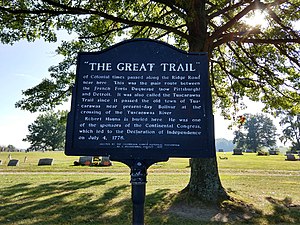Great Trail
This article needs additional citations for verification. (October 2017) |

The Great Trail (also called the Great Path) was a network of
Although some sections of the trail have been called "warpaths", such as the so-called "Great Indian Warpath" through Chillicothe, Ohio,[1] the primary purposes for these roads was peaceful trade, hunting, and gathering of natural resources along their routes.[citation needed] Some sources describe the Great Trail as beginning at one point or another. However, as there was a gradation between local trails used by few people and more major routes used by many, identifying a point at which the Great Trail begins or ends is an arbitrary matter.[citation needed] The Great Trail system connected with the Overland Trail, which led west, as well as other trails to other parts of the continent.[citation needed]
One part of the Great Trail system stretched from
Another part of the Great Trail system in New England was later followed by
In northern New Jersey, the portion of the Great Trail much-used by the Lenape included choice places to cross the Passaic River and to pass through the valleys among the Watchung Mountains, notably at Hobart Gap. As the Dutch colonists advanced beyond the proximity of the Hudson River, the new settlers found these paths crucial to their movement. New Jersey Route 24 generally follows a branch of the trail in this area.[citation needed]
A more southern part of the Great Trail system went from
As with the
References
- ^ a b Paul Wallace, Indian Paths of Pennsylvania, Old Forester
- ^ "A Landscape Planning Study of Webster, Massachusetts" (PDF). Archived from the original (PDF) on May 9, 2009. Retrieved December 26, 2006. Conducted by the University of Massachusetts Amherst Department of Landscape Architecture and Regional Planning.
- ^ Pocumtuc history, DickShovel
- ^ The Mohawk Trail
- ^ There’s More Than Rocks, Trees, and Streams In The Woods: An ACQTC Guide for Friends of the Quinnipiac to the Great Trail System of Connecticut, ACQTC Publications, 1999
Bibliography
- Ayres, Harral, The Great Trail of New England. Boston, MA: Meader Publishing Co. (1940)
